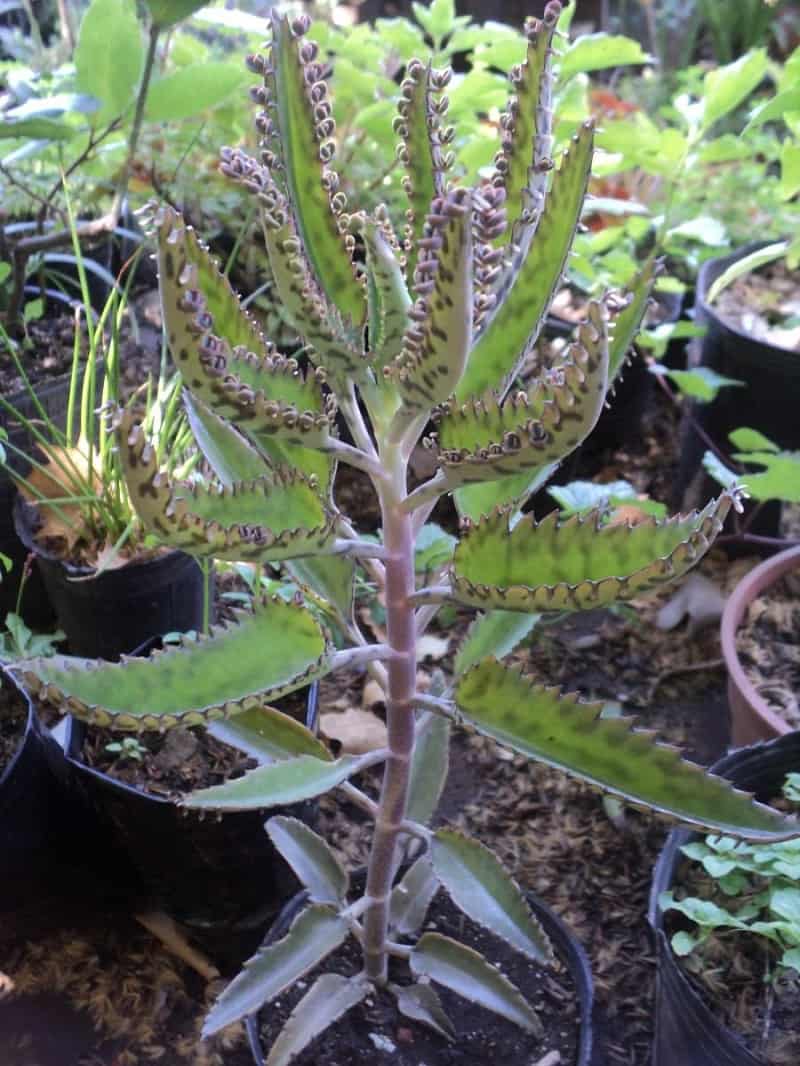The kalanchoe x houghtonii arises from the hybridization of the kalanchoe daigremontiana with the Kalanchoe delagoensis.
Its leaves are arched, boat-shaped, fleshy and green.
Usually, its leaves have spots purple in the margin and under the leaf.
Another characteristic of the leaves of this plant are the buds of new seedlings that are produced along the margin of their leaves which are easily detached from the plant.
They produce roots easily by being on the soil.
The stem can reach up to 1 m high; Its fleshy leaves can reach 15–20 cm long and about 4-5 cm wide.
Adult plants of the kalanchoe x houghtonii can develop lateral roots in the structures of their main stem, reaching 10–15 cm from the ground.
The leaves tend to develop in the upper part of the stem, which thus attains great weight, which causes the main stem to bend down and emit lateral roots, eventually producing the development of new primary stems that will be established as independent plants.
The flowering season of this species does not occur annually but occurs sporadically and, sometimes, the plant never blooms, the main stem extends vertically up to 30 cm in a couple of days, developing a terminal inflorescence (an umbrella-shaped cluster) with small pink bell-shaped flowers.
Tips to take care of the Kalanchoe x houghtonii
Lighting
This plant can be outside, in a space exposed to direct sun or semi-shade, protected from drafts and wind.
Or we can place it inside, but in a place where it receives enough sunlight.
Substrate
To grow this plant you can use a universal substrate lowered with some sand, so that it is loose, and add at the base of the substrate etch, to make the substrate have a good drainage, and so avoid root rot problems.
Watering
The kalanchoe x houghtonii is very resistant to drought.
This plant can pass without any problem, periods without being watered.
You should only water the plant when you see that the substrate is completely dry.
In winter and during the cold season we will reduce the risks, especially if the temperatures reach below 10 degrees C.
Flowering
As mentioned earlier, the flowering of this type of plant is very unusual, but in the case of flowering, it occurs in late winter or early spring, from the second year of growth.
Its flowers are given in groups in colorful tufts of pink bells.
When flowering ends, the floral wand must be cut.
Pruning and maintenance
It is a plant that can last between three and seven years, which does not need to be pruned, the only pruning that is done is when cutting the floral wand when it begins to wilt.
We will transplant normally every two years, we will observe that the plant will present the somewhat curved leaves facing down, and the roots will be tight, and almost without free substrate.
Pests and diseases
It is a species that is not usually affected by pests, in terms of diseases, the most frequent are those caused by fungi, which cause root rot and the appearance of white spots on the leaves, or the blackening of the points, so we will avoid wetting the leaves whenever we water the plant, and avoid waterlogging in the substrate, using good drainage, and watering only when the substrate is completely dry.
You may like: Mother of Thousands vs Mother of Millions
Propagation
This hybrid reproduces by seed and also vegetatively through the small seedlings that occur along the edges of its fleshy leaves and also on the branches of its old flower clusters.
You can also use the leaves that come off give rise to new plants.
If you are going to propagate the plant by seeds, you should only disperse the small seeds through the garden, or in a pot, with a specific succulent substrate.
Since the plant is of a good size you can transplant the plant to the place or pot where you want the plant to grow.
Water the seeds with an atomizer (you can do it daily), taking care that no puddles of water form in the substrate, and as the plant grows you must reduce the days of irrigation and wait until the substrate is dry before water it again.
If you propagate the plant cuttings (leaves of the plant) you just have to place the cuttings on the surface of the substrate until it begins to take root.
After the plant is of a good size you can transplant it to the place where you want the plant to grow.
Water the cuttings with an atomizer (you can do it daily), taking care that no puddles of water are formed in the substrate, and as the plant grows you must reduce the days of irrigation and wait until the substrate is dry before water it again.
Precautions
It is normal to confuse the kalanchoe x houghtonii with another type of Kalanchoe, since it is a hybrid of the daigremontian Kalanchoe with the Kalanchoe delagoensis.
But something very important and where you cannot be confused is that some types of Kalanchoe are for medicinal use, especially in Latin America, Asia and Africa are used to treating diseases and ailments, such as lessons, but the kalanchoe x houghtonii is not for medicinal use, since both its leaves and its stems are toxic and are not for human consumption.
For this reason, you have to be careful with the kalanchoe x houghtonii, and you should not for any reason consume this type of Kalanchoe.
